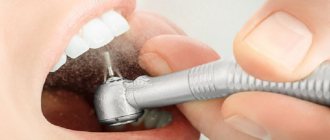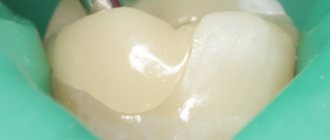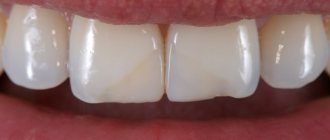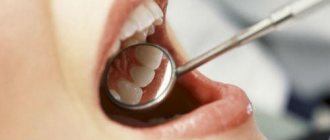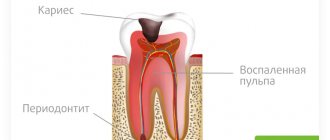February 24, 2020
Some patients, literally a few days after treatment at the dentist, discover that their temporary filling has fallen out. The situation is unpleasant, but not critical, and it is important to know what to do next in order to avoid subsequent complications. The editors of the UltraSmile.ru portal, based on the recommendations of experienced doctors, have prepared material on how to act in this situation, what the consequences of inaction are and whether it is possible to somehow protect yourself from such a problem.
Indications for installing a temporary filling
Some patients are sincerely perplexed and consider temporary filling an unnecessary measure. However, in fact, this is a very important stage in the treatment of teeth affected by deep caries, pulpitis, periodontitis, as well as in the presence of abscesses, cysts and granulomas.
The photo shows a temporary filling
The doctor resorts to temporary filling if it is not possible to carry out treatment in one stage or the inflammation needs to be eliminated. They also resort to a temporary solution while stump inlays and permanent prostheses are created for the patient in the laboratory. The filling serves as protection against external factors and bacteria. It prevents medications and antiseptics from coming out, which are placed inside the root canals and have a therapeutic effect.
“The doctor gave me a temporary filling just to see how the tooth would behave and whether complications would begin after treatment of deep caries. I carried it for about 5 days with severe pain, and then it fell out, after which the doctor said that we would remove the nerve from the tooth...”
Nadezhda, review from yell.ru
What to do if a temporary filling falls off?
Modern dentists in practice always adhere to the basic principle - you must try to save the tooth at all costs, and take any possible methods to restore its integrity and functionality, even in cases where the tooth is very problematic. In some rather complex clinical cases, it may take a little longer to cope with them. In such situations, treatment will involve several temporary stages, requiring two or more visits to the dentist. In order to protect the exposed tooth until the next visit to the doctor, a temporary filling will be required.
A temporary filling is usually installed in case of deep caries, when the inflammatory process affects the root canals, as well as in case of pulpitis. Such a filling is a special composition that is used to temporarily close the canals or cavity in the tooth in order to ensure protection and tightness of the opened cavities. At your next visit to the dentist, the temporary filling will be easily removed, after which the doctor will be able to continue to carry out the necessary medical procedures.
At its core, a temporary filling differs from a permanent filling in that it is not able to withstand constant or increased chewing load. Therefore, walking with her for a long time is unacceptable. Upon completion of treatment procedures, the temporary filling must be replaced with a permanent one.
How long do you need to wear a temporary filling?
Depending on the goals and clinical situation, it can remain in the oral cavity from 1 day to several months. For example, if arsenic was placed under it, with the help of which the nerve in the tooth is killed, then its removal is carried out within 1 to 7 days after installation.
If the “temporary” was installed to sanitize the canals before permanent filling, to treat an inflammatory process in the roots or in the pulp, then it can stand for several weeks or longer. Moreover, during each subsequent visit to the clinic, the doctor can replace one temporary filling with another, and put fresh medicine inside until the inflammation goes away. Sometimes treatment takes about six months.
What to do if for some reason (due to the patient’s negligence or mistakes made by the doctor) the filling material falls out?
What to do to prevent the filling from falling out.
If you want your dental fillings to last longer, try to avoid seeds, toffees and other foods that are harmful to them. Watch what you eat and check whether your foods contain enough calcium, vitamins and other substances that are good for your teeth. Be sure to brush your teeth and practice other oral hygiene habits regularly. Before filling your teeth, do your research and treat your teeth only with the best materials. Choose your dentist carefully and visit him at least once every six months.
Tip #1: Rinse your mouth thoroughly
If a temporary filling came out, then most likely there was a medicine underneath it (preparations based on calcium hydroxide, antibiotics, antiseptics and antimicrobial agents1), the purpose of which was to influence the diseased tooth and its canals from the inside. Under the filling materials there may also be a devitalizing paste based on arsenic.
It is important to rinse your mouth thoroughly
Medicines are covered with temporary materials not only so that they cannot leak out or be washed out by saliva and liquid, but also to protect the body from possible negative effects. For example, the same arsenic is toxic; after ingestion, it can cause poisoning, gastrointestinal upset, an allergic reaction and a rash. If the medicine comes out of the cavity and gets on the mucous membrane, this can lead to tissue irritation or burns.
To prevent the spread of medicinal compounds to the mucous membranes and their ingestion, thoroughly rinse the mouth with any antiseptic solution (for example, Chlorhexidine).
If a temporary filling falls out while eating food, do not swallow the food that was in your mouth at that moment, but rather spit it out.
A filling fell out: special reasons for women
In addition to the above factors, the destruction of fillings in women can accelerate for two reasons:
- menopause - due to impaired calcium absorption, bones and teeth lose strength;
- expecting a child - all nutrients are used for the development of the fetus, so pregnant women often lose fillings, and then their teeth very quickly collapse.
The fact that pregnant women cannot have their teeth treated is an unacceptable misconception. On the contrary, expectant mothers need to eliminate all foci of infection, including caries. The anesthetics used do not harm the child, the treatment is completely painless. However, it is advisable to carry out dental treatment in the second trimester of pregnancy.
Tip #2: Don’t rely on recommendations from online forums
A temporary filling has fallen out and you don’t know what to do in this situation? First of all, give up the idea of taking advantage of the dangerous recommendations of some Internet users. Under no circumstances should you do the following:
- cover the resulting cavity with chewing gum: you can introduce infection inside,
- pick out the remains of the filling and the medicine inside with a needle or other sharp objects: there is a high probability of damage to the soft tissues of the oral cavity. During the manipulation, there is a risk of breaking the needle, and it will be impossible to pull out the fragment on your own, which will lead to the development of inflammation. The use of sharp objects is fraught with the exact opposite effect - you will drive deeper the remains of the medicine and bacteria from the external environment,
- put antibiotics or tablets inside yourself: this can increase the pain and worsen the condition of the pulp, dentin and surrounding tissues.
Don't pick your teeth yourself
Tip #3: When eating, cover your tooth with cotton and don't chew on it.
Remember that in the absence of a temporary filling, the internal cavity remains defenseless against bacteria and small pieces of food. If food particles get into the root canals, it will be difficult to remove them, they will begin to rot, which will lead to an inflammatory process and the need to re-treat the canals. To protect the tooth from such a problem, before eating food, apply a sterile bandage or a piece of cotton wool to the opened cavity. For the same purpose, try to chew on the opposite side of the jaw.
A temporary filling is not only a “lid” that tightly closes the medicines inside, but also protection from external influences and damage. If the material falls out, the tooth becomes vulnerable, it is susceptible to bacteria and any mechanical stress, and can chip and break off. For this reason, you should also avoid chewing food (especially hard food) on a sore tooth. The thinner the tooth walls and the larger the size of the prepared cavity, the greater the likelihood of tissue destruction.
After each meal, it is important to rinse with antiseptics to “neutralize” bacteria living in the oral cavity and wash away food debris. If this is not done, then after removing the fleece, all this may end up inside an open cavity.
The filling fell out and the tooth chipped
The main hardness of the dental coating is given by mineral substances, which include: eight-calcium phosphate, hydroxyapatite, chloride and carbonate apatites.
Among the reasons why teeth may lose their natural strength are:
- unbalanced and unhealthy diet;
- age-related and other changes affecting the integrity of calcium tissues;
- disruption of intestinal function, as a result of which the absorption of minerals changes significantly;
- deviations caused by hormonal imbalances;
- Increased acidity of the oral cavity also affects the strength of the enamel.
Excessive load that occurs under the following circumstances can lead to tooth chipping:
- injuries resulting from falls;
- malocclusion;
- cracking nuts, or opening bottles with teeth;
- close contact of the teeth with fruit seeds, fish bones, chicken bones, and other hard food particles.
Provoking factors:
- weakening of the strength of teeth can also occur after removal of the nerve, since in this case the tooth becomes almost dead;
- Regular consumption of sweet, sour foods, or carbonated drinks
- insufficient oral care, as a result of which harmful bacteria accumulate in the oral cavity;
- temperature changes when eating hot food after cold food, and vice versa;
For your peace of mind, it is recommended to contact a good dental clinic.
Tip #4: Take pain medication
Immediately after installing a temporary filling, many patients complain of pain. Most often, the pain in the first hours and days is associated with the preparation of tissues and the fact that the medicine put inside has not yet fully worked, has not coped with the inflammatory process, and has not killed the pulp (if a devitalizing composition has been used). But if the material falls out, the pain usually intensifies. To eliminate it, take an analgesic from your home medicine cabinet, such as Nurofen or Ketanov.
Take a painkiller to relieve pain
Under no circumstances place an Aspirin or Analgin tablet into the tooth cavity, as some Internet sources advise! You can cause irritation, swelling and burns of the tissue, which will lead to an even more severe pain reaction.
To reduce pain, you can also use decoctions of chamomile and sage, a solution of soda and salt.
What to do if a filling falls out and your tooth hurts
A filling falling out of a tooth can also often be accompanied by pain. If you find that after “losing” a filling, your tooth is bleeding, or you simply experience unpleasant or acute pain, and there is no opportunity to see a doctor, you can numb the aching tooth yourself at home.
One of the main ways is painkillers! Yes Yes! Exactly! However, the tablet should not be chewed, swallowed, or taken with water as usual. The only and surest way is to hold an analgin tablet (for example) near a sore tooth until it completely dissolves.
By breaking down, the soothing properties of the tablet penetrate into the filling cavity, bringing the nerve into a calmer state, soothing and comforting the pain threshold of the tooth surface. And you don’t have to worry about the filling falling out, since a professional dentist can easily and quickly correct this unpleasant situation.
And remember! Do not try to replace a fallen filling under any circumstances, as this may lead to deterioration of the tooth surface.
Tip #5: See a doctor immediately
A temporary filling fell out: what to do? The only right decision is to make an appointment with a doctor as quickly as possible, even if you visited him a few days ago and a return visit was not part of your plans.
Remember, a temporary filling is evidence that the tooth has not yet been fully healed or restored. If it falls out, this increases the risk that you will then have to start a long, expensive treatment all over again or be left without a tooth altogether. If the infection in the root canals is not completely destroyed at the time the temporary material falls out, then it can easily spread to neighboring units and tissues and move through the circulatory or lymphatic system to internal organs.
You should contact your dentist as soon as possible
In the absence of measures, the likelihood of the crown chipping and its complete destruction, injury and damage to the mucous membrane increases (after all, after the materials fall out, the resulting cavity may have sharp edges).
What to do when a filling falls out
Further treatment tactics depend on the patient’s behavior after the temporary filling falls out. If you do not take any action and wait for your appointment, then most likely the doctor will have to re-clean the tooth cavity or even carry out additional procedures to eliminate pathological processes that have arisen due to external factors. An open tooth is accessible to all infections and is highly undesirable at any stage of treatment.
If the filling falls out on the day of installation
In cases where the temporary filling falls out after 2 hours or approximately this time, you must immediately contact a specialist for re-filling.
What should you do if a temporary filling falls out in the evening, when you can no longer visit the dentist? In such a situation, it is necessary to close the cavity. For this, for example, you can purchase a special dentin paste or its analogues at the pharmacy. You should try to remove the remains of the filling, but without using sharp objects, so as not to damage the internal tissues and channels. After this, the cavity is filled with paste, and the next day they are sent to the attending physician.
If it is not possible to purchase such a paste, it is recommended to minimize food intake and constantly rinse your mouth with mouthwash or other antiseptic agents. Rinsing is necessary after each meal to flush out food particles from the exposed tooth that may get into the cavity.
Loss of filling in sealed and unsealed canals
The greatest risk occurs when a temporary filling falls out and the canals are not sealed. Due to the high probability of contamination of the dental canals, the patient should also “seal” the tooth with paste, or rinse the tooth regularly. You can also use a soda solution for rinsing. On the same day or the next day, the patient must go to the clinic to take measures to close the cavity in the crown.
If a temporary filling falls out, but the canals are sealed, what should I do? In such patients, the likelihood of complications is minimal, since neither infection nor foreign particles can penetrate into the canals themselves. But it is still impossible to leave the cavity open, since the crown is weakened and its internal tissues are not protected from mechanical stress. Patients are also advised to rinse as a preventative measure and to see a dentist again, who may even install a permanent filling right away.
Measures to help prevent temporary fillings from falling out
In order not to think about what to do if a temporary filling falls out, try to prevent such a situation after its installation. To do this you need to adhere to the following rules:
- in the first 2 hours after installation, refrain from eating any food so that the materials finally harden and acquire the desired shape,
- exclude hard foods, nuts, and sticky foods from your diet: temporary fillings are softer than permanent fillings, they can easily crumble, break off or fall out,
- try to chew on the side opposite to the one where the treatment was carried out,
- refuse to use irrigator and floss in the area of localization of temporary materials,
- Carefully inspect the seal every day for chips and cracks: if even small leaks appear, you should consult a doctor.
Eliminate solid foods from your diet
As you can see, there is nothing difficult about keeping a temporary filling in place. If it falls out before the scheduled visit to the dentist, then there is nothing to worry about in this situation, provided that you act correctly and do not put off going to the doctor for a long time.
Notice
: Undefined variable: post_id in
/home/c/ch75405/public_html/wp-content/themes/UltraSmile/single-item.php
on line
45 Notice
: Undefined variable: full in
/home/c/ch75405/public_html/wp-content /themes/UltraSmile/single-item.php
on line
46
Rate this article:
( 7 ratings, average: 4.00 out of 5)
dental fillings
- Fedorinchik O.V. Frequency of use of calcium hydroxide preparations by dentists in the treatment of complicated caries. – Modern dentistry, 2011.
Expert “A temporary filling is not intended for long-term use, so if the doctor installs it, he must inform the patient when the next visit to the clinic needs to be made for removal or replacement. But not all people come on the appointed day, some postpone the issue for a week or even longer - and this explains why the integrity and tightness of the material is gradually being compromised.” Dentist-therapist Elena Vladimirovna Orlova
Consulting specialist
Orlova Elena Vladimirovna
Doctor rating: 9.5 out of 10 (2) Specialization: Dentist-therapist Experience: 33 years
Types of dental fillings and their reliability
Depending on the period of use, materials can be permanent or temporary. The first ones have been used for a long time. The base is safe, durable, and has good aesthetic characteristics. Temporary fillings are installed only for the period of treatment along with medications.
Based on materials, the base can be of the following types:
- Cement. No special tools are needed during installation; even a novice specialist can perform the work. Disadvantages - the initial volume, and the shape is quickly lost, susceptibility to mechanical stress.
- Plastic. The material hardens quickly. The filling is durable and can be used for a long time; the shade matches the color of natural enamel. Disadvantage: rapid deformation.
- Amalgam. Rarely used due to low aesthetic characteristics. But thanks to the large amount of metal in the material, they last a very long time.
- Ceramic. The durable base is not subject to mechanical stress and temperature fluctuations, retains its color and shape.
- Photopolymer. The material is plastic, has good aesthetic characteristics, and quickly adheres to molars.
- Glass ionomer. Used in children's clinics. They prevent the reappearance of carious formations, provide good adhesion to molars, are easy to install, and have a low degree of shrinkage. Disadvantage: low strength.
On a note! If a piece of a tooth breaks off, you need to consult a doctor, who will select the type of material to close the canal and restore the shape of the molar. Here everything will depend on the patient’s capabilities, characteristics of the body, and oral cavity.
Comments
The doctor recently put in a temporary filling, told me to come back only in a week, but the tooth underneath it hurts very much, I can’t stand it, I’m very, very nervous... Is it possible to somehow pull it out ahead of time?
Kira (03/02/2020 at 00:55) Reply to comment
- Dear Kira, pain after installing a temporary filling can indicate both a pathological process and be a normal tissue reaction to the intervention. In both cases, you cannot try to remove the filling yourself, but it is not forbidden to visit a doctor unscheduled - the specialist will determine the true cause of the pain, and you will stop being nervous.
Editorial staff of the portal UltraSmile.ru (03/11/2020 at 09:04) Reply to comment
If you followed all the recommendations of your dentist, but the temporary filling still fell out, then this is a reason to think about changing your dentist. I think so. Where is the guarantee that he will then install the permanent one poorly?
Pavel (03/20/2020 at 10:07 am) Reply to comment
Good afternoon I once had a tooth crumble and its treatment took several days. They gave me a temporary filling and told me not to eat for several hours so that everything would harden. The remains of the tooth did not hurt under the temporary filling, since my nerve was removed, but if they put a temporary filling on the tooth where caries was treated, how to avoid pain?
Dmitry Ch. (03/20/2020 at 11:29 am) Reply to comment
At the appointment, the doctor began treatment and placed a temporary filling. The next visit was scheduled in five days. But the tooth began to bother me in the evening after visiting the doctor. Tell me if you need to see a doctor earlier than the appointed day
Svetlana (03/20/2020 at 11:56 am) Reply to comment
Tell me, if the temporary filling fell out over the weekend and my doctor doesn’t have an appointment for the next few days, will I have to walk around with cotton wool in my tooth? Maybe there is some special remedy for the time being?
Maria K (03/20/2020 at 12:12 pm) Reply to comment
My son is 10 years old. They put a temporary filling with medicine, the doctor told me to come back in 10 days. 5 days have passed, the tooth hurts. What should we do when we go to remove the tooth?
Tatyana (03/20/2020 at 01:03 pm) Reply to comment
Hello. I would like to know the opinion of a professional, because different doctors answer my question differently. Back in the days of the Soviet Union, I was given a filling. It does not have a very aesthetic appearance, it is dark in color and those who are not in the know always point out to me that the tooth needs to be treated. Do you think it’s worth changing it if the tooth itself doesn’t bother you and the filling is done, as they say, to last forever. Or is there some modern way to simply cover up the color of the filling? Best regards, Asya.
Asya (03/20/2020 at 14:01) Reply to comment
This is terrible, I swallowed a temporary filling, what will happen now?
Tatyana (03/22/2020 at 06:14 pm) Reply to comment
- Modern filling materials are safe and, if swallowed, do not cause serious consequences for the body. But the medications that are under them can provoke irritation and upset of the gastrointestinal tract, and an allergic reaction. But in any case, there is no need to be nervous, because the dose of medications is small, they cannot cause serious harm to an adult body. To neutralize the negative effects of medications, you can take Polysorb and an antihistamine (for example, Zodak). Also be sure to contact your dentist to have the filling reinstalled or a permanent restoration done if necessary.
Editorial staff of the portal UltraSmile.ru (03/27/2020 at 09:27) Reply to comment
Good afternoon Please tell me, four days ago I got a temporary filling. At first everything was fine, but a couple of days ago my tooth started to hurt horribly. I called the clinic and they told me that there was nothing wrong with it and that you would come for an appointment in 6 days. I wanted to know if this is normal or is it better to go to another doctor? Because I don’t understand anything at all about dentistry.
Yana (04/23/2020 at 07:42) Reply to comment
Please specify what is the maximum service life of a temporary filling? My husband was given a temporary filling and an appointment was scheduled for only a month later. Now I’m worried whether wearing it for such a long time will have a negative impact, because about ten years ago my colleague delayed her visit to the dentist after installing a temporary filling, which led to tooth extraction.
Victoria (04/23/2020 at 07:53) Reply to comment
Why does a temporary filling still fall out, even if the patient was careful and followed the dentist’s advice? Maybe, among other things, there is some kind of rejection by the body of the materials that make up its composition?
Dmitry (04/23/2020 at 08:56) Reply to comment
Hello, what could be the reasons for a temporary filling falling out? Unprofessionalism of the doctor? Or something else more significant? Is it true that a temporary filling is harmful to the body?
Mikhail (04/23/2020 at 09:09) Reply to comment
Write your comment Cancel reply
A child's fillings fall out of his baby teeth
The destruction of fillings on baby teeth is associated with the following factors:
- Enamel and dentin in children are much weaker than in adults.
- The skills of proper brushing of teeth are not sufficiently developed.
- Frequent dental problems associated with dirty hands.
- Fidgets injure their teeth by falling and chewing hard objects.
- Children love to drink cola. With constant consumption of a drink containing phosphoric acid, teeth are destroyed and fillings fall out.
- Parents mistakenly refuse to install an inlay or crown on a badly damaged tooth for their child; instead, they insist on building it up.
What to do if a child’s baby tooth filling falls out? Re-filling is required. Tooth extraction is not advisable, as problems with bite may arise in the future. Leaving a damaged tooth without a filling is also not worth it. Repeated caries will negatively affect the condition of the rudiments of permanent teeth.
